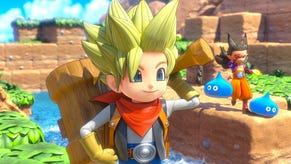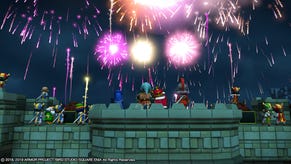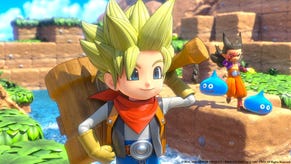Dragon Quest: Builders PlayStation 4 Review: Fables of the Reconstruction
A brilliant marriage in which two very different types of game — Minecraft and the classical console RPG — come together to find their common ground.
This article first appeared on USgamer, a partner publication of VG247. Some content, such as this article, has been migrated to VG247 for posterity after USgamer's closure - but it has not been edited or further vetted by the VG247 team.
The idea of Dragon Quest: Builders appealed to me from the beginning. I love Dragon Quest, and I find the concept of Minecraft intriguing but lack the kind of free time that its open-ended freedom demands. Combine the two and you'd have, presumably, a good game.
I was mistaken, though. Dragon Quest: Builders isn't good; it's excellent. What surprises me most about it, I think, is just how well it works as Dragon Quest. The Minecraft element seems fairly obvious, what with the world made of one-meter cubes that you can break down, carry around, and reassemble more or less any way you please. And yes, it wears the Dragon Quest identity cosmetically: Besides all the familiar enemies wandering around and all the iconic sound effects they make as they cast magic spells, many of the blocks that make up the world are essentially cubic versions of the 8x8-pixel bitmap tiles that comprised the original NES game's world and town maps.

But that in itself means nothing. I've seen no shortage through the years of games that wear a beloved franchise's skin without giving any particular heed to its essence. Builders doesn't make that mistake; not only does it look the part of a sequel to the original Dragon Quest, it nicely captures the spirit of the games. One of the series' core strengths has long been the stories you experience as you travel from town to town, and Builders turns that inside-out: You set up a different town as your base of operations for each chapter, drawing residents from across the land to make the newly restored city their home. While this home base approach represents a shift from the picaresque style of standard Dragon Quest games, in which you typically pass through a village for a few hours at most en route to solving the world's problems, this only serves to strengthen the game. Each NPC has his or her own personality, from gregarious fool to melancholy to coward, and their aspect slowly matures as your accomplishments mount and your town grows. So, while Builders contains plenty of fan service for anyone who remembers the original Dragon Quest, it also works well as a standalone tale.
The fan service deserves plenty of respect, though. Builders exists on the framework of the game that kicked off the long-running RPG series, literally: The world map, which you only ever see as small portions, exists atop that of the original game. Since this is a real-time 3D action game rather than a turn-based RPG with random encounters, Builders offer a chance to immerse yourself in one of gaming's classic worlds; honestly, this has even more impact than moving through faux-recreations of Super Mario Bros. World 1-1, because this world was meant to be a vast and sprawling setting from the beginning. Now, it truly is as vast and sprawling in a way the NES could never depict it, and on top of that you can make your way through it practically any way you like.
The story makes use of key moments from the first Dragon Quest, too. The first town you restore is Cantlin, which in the original adventure presented you with one of the game's handful of boss encounters in the form of a powerful golem that protected the city gates. The golem plays a major part in Cantlin's restoration, and the ultimate story behind its appearance here feels very true to the bittersweet spirit that drives many Dragon Quest story vignettes. The little nods are great as well, such as the thoughtful attempts to integrate the localization of the old NES games with the series' current style. Your encounters in the present day have the same slightly goofy, pun-filled, dialect-based style as other current Dragon Quest games, but your flashbacks to the original game's quest uses the stilted, faux-Shakespearean style of "thees" and "thous" from the NES games, back when it was "Dragon Warrior." It's clearly a game that a lot of love went into, and it shows.

Builders doesn't work quite as well on the Minecraft front, if only due to its restrictions. This isn't like setting up a Minecraft server and just going for it. The game world features remarkable persistence to be sure — drop an item on a remote isthmus somewhere and you'll still be able to come back and collect it a dozen hours later, and the tunnels you dig through mountainsides remain forever... as do the hideous scars in the landscape left behind by explosions. And there's something marvelously empowering about seeing a mountain range in an RPG — normally an impassable tile — and just boring right through it to the other side. Nevertheless, this is a relatively basic building simulation. The world has a fairly shallow fixed bottom, allowing you dig only two blocks beneath the surface of water. Your hero or heroine can't swim, so deeper water constitutes something of a hard demarcation; you might think, "Well, I can just build a bridge over that," but no, you can't. There's an invisible barrier over any deep water, even narrow lengths of water between jetties — a frustrating limitation.
Even so, Builders provides you with plenty of freedom to build. I've taken a fairly straightforward approach with the game, what with my need to get it completed and reviewed (and even then I still have a long way to go). For those not constrained by the requirements of their job, though, Builders offers a fantastic array of construction options — and you build on your knowledge quite quickly. As you complete quests, you learn new crafting techniques, which in turn allow you to create better tools and weapons, which in turn allow you to fight monsters and gather materials more efficiently.

The greatest strength Builders possesses, in fact, is the way it so brilliantly combines the feedback loops of both Minecraft and Dragon Quest into an RPG-like system of skills and mechanics. For once, leveling up means something more than hitting harder and having more hit points. Certainly those things emerge as a matter of course during Builders, but they're more of a side effect, a means to an end. You don't level up your protagonist here but rather your town, which makes your townspeople smarter and unlocks new perks. In other RPGs, you roam around and earn gold so you can buy better armor; here, you make better armor yourself, which comes about as a side effect of learning to refine iron ore into steel, which you can do once you unlock a furnace, for which you need to complete a specific quest, which can only be completed once you've constructed a tool capable of breaking through hard rocks, for which you need a certain number of resources farmed from creatures that appear at the far end of the desert, which you can't reach until you complete the quest that unlocks the teleporter to the desert... and so forth. RPGs often have interlocking quests, but those typically feel arbitrary and rote. In Builders, the quests build on each other and create a fantastic sense of accomplishment.
The game has only a handful of flaws from what I've played so far. Besides the limitations to exploration and digging, you also have to deal with a camera not entirely suited for the genre. Builders places you in control of an avatar seen through the third-person view, and while it's possible to bring the camera in-close while you tunnel through narrow spaces, it never works quite as effectively as a proper first-person viewpoint. This doesn't break the game, but it certainly does make construction and mining inefficient.
I'm also not a fan of the boss battles, which feel decidedly out of place here. Worse, they arbitrarily break the game's own principles. The first boss, for example, attacks the town you've worked so hard to create, smashing it apart with boulders that demolish your construction. You can create shields to protect it, but I locked myself into an unwinnable state by anticipating the battle's goals ahead of time: The NPC dialogue made it clear I would need to erect those shields, so I did it in advance, placing them around the perimeter of the town. When the battle began, however, everything outside the town's borders was de-instanced, meaning those hard-crafted shields vanished into air. For a game whose core principles involve permanence and persistence, this felt like a massive violation of its own spirit.
Fortunately, these grievances are fairly minor in the grand scheme of the game. I would prefer a little more freedom in building, the ability to toggle into first-person view when necessary, and fewer out-of-place bosses (or maybe none at all). And this game is just begging for cooperative play. Overall, however, Builders has proven to be an addictive, involving adventure that combines two fundamentally different kinds of game and makes you realize that maybe they're not so different after all. For those who wish console RPGs had a little more freedom and for those who wish construction games had a little more direction, Dragon Quest: Builders finds a clever midpoint between the two. It's not a pure take on either genre, but instead a wholly unique combination of the two — wholly fitting for a game that revolves around taking two different things and combining them into something better.

InterfaceBuilders manages to make a complex concept fairly simple, but more button customization would be ideal.
Lasting AppealThe core game can easily run anywhere from 60-100 hours, and that's before you take the true Terra Incognita sandbox into account.
SoundWonderful music and iconic sound effects... though the grunts of your avatar's exertion can become annoying.
VisualsWhile some might complain about the sub-60fps framerate, Builders offers a huge, persistent, completely destructible world with a lovely plasticine sheen. It's great.
ConclusionStriking an almost perfect balance between RPG and construction game, Dragon Quest: Builders manages to hold fast to the best parts of the series whose name it bears while creating a guided, structured format for the Minecraft concept. The end result works brilliantly, with top-notch visuals, music, and writing that help drive home the appeal. There's room for improvement here... but not much.

What does it mean, exactly, for something to capture the "spirit of Dragon Quest"? That seems like such a vague assertion to make as part of a review — and yet, I can think of no higher praise for the series' latest spinoff. Dragon Quest: Builders may not be a numbered entry in the long-running franchise, but it truly does embody everything I love about this unassuming juggernaut of the role-playing realm.
No two Dragon Quest games play exactly the same, or share an identical narrative structure. Builders does a great job of assimilating one of the series' most popular formats, though: The vignette storyline. Back with Dragon Quest IV, developers Chunsoft and Enix put a new spin on the RPG by dedicating the first half of the game not to the hero's journey but rather on the stories of the hero's companions. The opening chapters of the adventure turned the supporting cast members into fully fleshed-out characters with their own motives and histories — a far cry from the typical generic, replaceable soldiers of other RPGs. Since then, many Dragon Quest adventures have gone back to that same thematic well: The idea that the most interesting story to be told is not that of the player's journey, but those of all the people in the world whose lives are impacted by the rise of evil and the player's quest to destroy the villain.
Builders takes this concept to a new level. Like the venerable Dragon Quest IV, it too operates within a chapter-based structure. In effect, it combines the character-based chapters of DQIV with the town-based vignettes of Dragon Quest VII and IX into a set of four chapters that each revolves around the reconstruction of a different city. Each chapter stands alone, as did the ones in DQIV, and each one follows a single central narrative thread into which both NPC stories and a logical progression of play mechanics have been woven. It all fits together wonderfully — and it also makes Builders much less daunting a task to complete than, say, the recently remade Dragon Quest VII. You can easily spend 20-30 hours on a single chapter if you choose to complete each one's optional side quests, but because each town's tale is a self-contained play experience, you don't really need to complete Builders in a single playthrough.

In fact, Builders probably works best if you don't marathon it. Each new chapter resets your character's progression: Your hero (or heroine) is reverted to novice level, forgetting the construction techniques they learned in the previous village and forced to rebuild their skills and stamina from scratch. Played in rapid succession, these four chapters can cause you to feel somewhat like you're spinning your wheels as you go back to zero with the advent of each new town.
That said, it's not as though each new chapter thrusts you back into tutorial mode. Where the first chapter doles out new construction techniques as a sort of slow drip, you come into your own far more quickly in the subsequent towns. Once you set up your base flag, you'll almost immediately gain access to tools, weapons, and creations that took hours to acquire in the Catlin phase. Because the nature of the resources available to gather in each region vary from chapter to chapter as well, you don't follow the exact same progression each time around. And on top of that, each village poses its own distinct objectives and challenges — making every chapter its own little mini-RPG. Honestly, I wouldn't be shocked to discover that Square Enix had originally intended Builders to be part of its recent move toward episodic content; each Builders chapter plays like a rich, substantial episodic release.
On top of that, once you've completed the first chapter, you unlock Terra Incognita mode. Simply put: A free-building mode without the narrative structure. A pure Minecraft experience, basically. The more chapters you complete, and the more optional objectives you fulfill without those regions, the more territory and materials you unlock for Terra Incognita. This makes for a far more impressive 100% completion bonus than simply racking up a Platinum trophy — by mastering the main game, you unlock an effectively endless sandbox. In other words, if you love the game, your reward for playing it is more game. That's a pretty appealing feedback loop!
While my criticisms of Builders' small flaws remain (especially regarding boss battles, which aren't unmanageable but definitely abrogate much of the game's central concept), they remain modest issues at worst. On the whole, however, what I discovered in Builders was the rarest of treats: A game for which I had high expectations... yet which somehow managed to exceed them all. It turns out RPGs and construction games have a lot in common, and that the predominant story theme which drives the Dragon Quest series — restoring hope for humanity in the face of oppressive evil — provides a brilliant hook for a sandbox adventure.

InterfaceBuilders manages to make a complex concept fairly simple, but more button customization would be ideal.
Lasting AppealThe core game can easily run anywhere from 60-100 hours, and that's before you take the true Terra Incognita sandbox into account.
SoundWonderful music and iconic sound effects... though the grunts of your avatar's exertion can become annoying.
VisualsWhile some might complain about the sub-60fps framerate, Builders offers a huge, persistent, completely destructible world with a lovely plasticine sheen. It's great.
ConclusionStriking an almost perfect balance between RPG and construction game, Dragon Quest: Builders manages to hold fast to the best parts of the series whose name it bears while creating a guided, structured format for the Minecraft concept. The end result works brilliantly, with top-notch visuals, music, and writing that help drive home the appeal. There's room for improvement here... but not much.
















